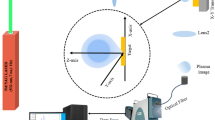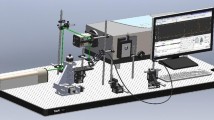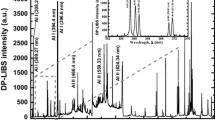Abstract
In this work, we suggest a method for electron impact width parameter calculation based on Stark broadening of emission lines of a laser-ablated plasma plume. First, electron density and temperature must be evaluated by means of the Saha–Boltzmann plot method for neutral and ionized species of the plasma. The method was applied for laser-ablated molybdenum plasma plume. For molybdenum plasma electron temperature, which varies around 10,000 K, and electron density, which reaches values around 1018 cm−3, and considering that total measured line broadening was due experimental and Stark broadening mainly, electron impact width parameter of molybdenum emission lines was determined as (0.01 ± 0.02) nm. Intending to validate the presented method, it was analyzed the laser-ablated aluminum plasma plume and the obtained results were in agreement with the predicted on the literature.
Similar content being viewed by others
Avoid common mistakes on your manuscript.
1 Introduction
Despite its extensive utilization, the basic research related to molybdenum, and more specifically to Mo plasma, is still scarce and just recently it is advancing. For example, even the NIST database [1, 2] is poor in spectroscopic data for Mo.
In last years, some results for Mo plasma have been published. Jakubowska indicated the presence of six-time-ionized atoms in laser-ablated molybdenum plasmas by ion energy analyzers and measured the electron temperature for neutral species with values nearly 1.5 eV [3]. Farid and Hanif measured the electron density, the order of 1017 cm−3, by Stark broadening of emission lines and the electron temperature by Boltzmann plot, around 10,000 K. Farid demonstrated that both electron temperature and electron density values increase with increasing pressure of background gas at vacuum chamber, while Hanif reveals the decreasing behavior of this values along expansion axis of plasma plume [4, 5]. However, it is important to note that these measurements were made considering reference data for other metals, like the case of the Fe electron impact width parameter used for electron density determination on Mo plasma by Stark broadening.
This paper presents the suggestion of a method for electron impact width parameter calculation, which was unknown for molybdenum, based on Stark broadening of Mo emission lines. To do so, electron temperature and electron density along plume expansion axis were first determined on a space-resolved spectroscopic study of Mo laser-ablated plume [6–8]. Measurements for laser-ablated aluminum plasma, electron impact width parameter of which is well-known, were made intending to validate the proposed method [9].
2 Experimental setup
Figure 1 presents a schematic diagram of the experimental setup for spectra acquisition.
Experimental setup [6]
Coherent AVIA 355-X Nd:YAG laser emitting pulses with 0.205 mJ energy and 25 ns duration (FWHM) in third harmonic (355 nm) were focused on a molybdenum solid sample with a laser fluence of 6 J/cm2.
The target was fixed to a XY table controlled by computer to avoid cratering and placed inside a vacuum chamber. All spectroscopic measurements were made considering plasma expansion in air at atmospheric pressure.
The molybdenum spectra were acquired by imaging the plume through a two times magnification telescope and collecting the light emission at the image position with a fiber-optic cable, on a XY positioner, and coupled to a Triax 550 Jobin–Yvon spectrometer, set to work with an ICCD DiCAM-PRO.
The emitted light from plasma plume is space resolved along expansion axis and time integrated. The time integration was fixed equal to 2.0 ms and repetition rate of laser pulse was equal to 1.2 kHz, so the intensity of acquired spectra is due to the plasma generated by interaction of few laser pulses with the target. Spectra acquisitions were synchronized with the beginning of the laser pulse.
3 Results and discussion
Commonly, after spectra acquisition, assignment of emission lines is made for direct comparison of acquired spectra with emission line tables presented on NIST [1, 5]. However, since the database for molybdenum is poor, assignment of experimental molybdenum emission lines was made by comparing the experimental with theoretical spectra. The theoretical spectra were built through a collection of molybdenum database on the literature [1, 2, 10].
The Local Thermodynamic Equilibrium Model describes laser-ablated plasma plume. In this case, Saha–Boltzmann equation relates the electron density of the states with electron temperature for different ionization stages [11–13]. For molybdenum, the literature presents reference data only for neutral and singly ionized atoms [1].
Equation (1) is Saha–Boltzmann equation, which relates the intensity (I +) of singly ionized emission lines and the intensity (I 0) of neutral emission lines with electron temperature (T) and electron density (N). In this equation, λ is wavelength of emission line, A is spontaneous emission coefficient, g is degeneracy, m e is electron mass, k B is Boltzmann’s constant, h is Planck’s constant, and E +, E 0 and E i are ionized state energy, neutral state energy and ionization energy, respectively. Note that the sub-index + refers to singly ionized atoms and sub-index 0 refers to neutral atoms.
Like in Boltzmann plot, in Saha–Boltzmann plot (Fig. 2), the temperature is determined from the slope of the linear fitting from taking the log of Eq. (1).
It is possible to determine the spatial evolution of electron temperature by calculating electron temperature by Saha–Boltzmann plots for different positions along plume expansion axis. Figure 3 shows spatial evolution of electron temperature along plume expansion axis at atmospheric pressure. The electron temperature average value is around 10,000 K and its value decays as plasma expands, which is consistent with the literature [3–7].
The absolute values of electron density of molybdenum plasma can be determined by replacing electron temperature values obtained by Saha–Boltzmann plot in Eq. (1). Figure 4 indicates the electron density values along plasma plume expansion axis at atmospheric pressure and reaches values around 1018 particles/cm3.
Another source of information for plasma characterization, besides the intensity of emission lines, is broadening mechanisms. For molybdenum emission lines of laser-ablated plasma, Doppler broadening is much smaller than Stark broadening and can be neglected [12]. This way, in an approximation, it can be considered that total broadening of molybdenum emission lines is due to instrumental broadening and Stark broadening.
Instrumental linewidth can be obtained by fitting the scattered laser light line profile to a Lorentzian equation, shown in Fig. 5. The calculated instrumental broadening was equal to (0.056 ± 0.002) nm.
If an experimental emission line can be fitted by a Lorentzian profile, the Stark linewidth is the difference between total linewidth and instrumental linewidth. Figure 6 shows a typical plot of Lorentzian fit for an experimental emission line. The determination of total linewidth was made for evolution of 313.35 nm emission line along expansion axis at atmospheric pressure, which varied between (0.182 ± 0.009) nm and (0.128 ± 0.005) nm. The difference between total linewidth and instrumental linewidth results in Stark linewidth.
Usually plasma electron density is determined by Stark broadening (Eq. 2), expression of which depends of electron impact width parameter (ω). However, for molybdenum, this electron parameter is unknown and, once electron density was determined by Saha–Boltzmann equation, Stark broadening expression can be used to determine the electron impact width parameter [5].
Replacing the Stark linewidth calculated previously in Eq. (2), it permits to calculate electron impact width parameter. The calculated value of molybdenum electron impact width parameter is equal to (0.011 ± 0.021) nm for temperature equal to (12,035 ± 3064) K.
In the literature [9], electron impact width parameter is shown as a function of temperature. However, the calculated temperature range is much smaller than temperature values at electron impact width parameter plots presented in the literature. This way, the presented value is the average of the obtained values along the plume expansion axis and has the same order of magnitude of other metals [9, 14].
It is important to note that the error bars on electron temperature and electron density plots, and the uncertainties for electron impact width parameter measurements, considered propagation of errors.
Intending to validate the method for electron impact width parameter calculation based on Saha–Boltzmann and Stark broadening equations, all experiments as described for molybdenum measurements were repeated for a well-known metal—the aluminum. At this time, spectra were acquired for only one position at plume expansion axis, in which the intensity of emission lines presents a maximum. Neutral and singly ionized aluminum lines were considered for Saha–Boltzmann plot, so the electron temperature was equal to (16,365 ± 1875) K and the electron density equal to (1.2 ± 0.6) × 1017 cm−3. The aluminum emission line considered for Stark broadening measurements was the 396.15 nm, and the calculated electron impact width parameter was equal to (0.022 ± 0.012) nm. The reference value for aluminum electron impact width parameter is 0.018 nm for temperature equal to 20,000 K.
So, it is possible to assure that the proposed method can be used to determine electron impact width parameter for elements whose parameter is still unknown, and also this method replicates the values for those elements whose parameter has been calculated.
4 Conclusions
A method for electron impact width parameter determination was suggested for laser-ablated plasma plumes. The method is based on evaluation of Stark broadening of emission lines, since the electron temperature and electron density were first calculated.
The method was applied for molybdenum electron impact width parameter determination. For this, space-resolved spectroscopic studies on a laser-ablated molybdenum plasma plume were performed intending to determine electron temperature and electron density. These parameters were calculated along plasma expansion axis in air at atmospheric pressure considering Local Thermodynamic Equilibrium and described by Saha–Boltzmann equation. For electron temperature, the average value is nearly 10,000 K, and its value decays as plasma expands. Electron density range is 1010–1018 cm−3. Usually, electron density is calculated by Stark broadening, but for molybdenum, the electron impact width parameter that appears on Stark broadening expression is unknown. Once electron density was determined through Saha–Boltzmann equation, the Stark broadening of 313.35 nm emission line was used to calculate electron impact width parameter for molybdenum, which at (12,035 ± 3064) K was (0.01 ± 0.02) nm.
References
NIST Atomic Spectra Database. http://www.nist.gov/physlab/data/asd.cfm. Accessed 21 Nov 2012
D.R. Lide, Handbook of Chemistry and Physics, 87th edn. (CRC Press, Boca Raton, 2006–2007)
K. Jakubowska, M. Kubkowska, A. Blagoev, M. Rosinski, P. Parys, P. Gasior, Phys. Scr. T161, 014029 (2014)
N. Farid, H. Wang, C. Li, X. Wu, H.Y. Oderji, H. Ding, G. Luo, J. Nucl. Mater. 438, 183–189 (2013)
M. Hanif, M. Salik, J. Russ. Laser Res. 35(3), 230–238 (2014)
E.M.A. Sternberg, N.A.S. Rodrigues, M.E. Sbampato, J. Amorim, C.A.B. Silveira, Appl. Phys. B 116(4), 985–989 (2014)
E.M.A. Sternberg, N.A.S. Rodrigues, J. Amorim, M.E. Sbampato, J. Phys. Conf. Ser. 370, 012052 (2012)
J.B. Matos, M.L. Oliveira, E.M.A. Sternberg, M.G. Destro, R. Riva, N.A.S. Rodrigues, J. Aerosp. Technol. Manag. 4, 413–420 (2012)
H.R. Griem, Stark broadening parameters for neutral and singly charged ions. http://griem.obspm.fr. Accessed 29 Oct 2015
P. Palmeri, J.F. Wyart, Phys. Scr. 58, 445–456 (1998)
C.A. Bye, A. Scheeline, Appl. Spectrosc. 47(12), 2022–2030 (1993)
J.A. Aguilera, C. Aragón, Spectrochim. Acta Part B 59, 1861–1876 (2004)
J.A. Aguilera, C. Aragón, Spectrochim. Acta Part B 62, 378–385 (2007)
N. Farid, S.S. Harilal, H. Ding, A. Hassanein, J. Appl. Phys. 115, 033107 (2014)
Author information
Authors and Affiliations
Corresponding author
Rights and permissions
About this article
Cite this article
Sternberg, E.M.A., Rodrigues, N.A.S. & Amorim, J. Molybdenum electron impact width parameter measurement by laser-induced breakdown spectroscopy. Appl. Phys. B 122, 21 (2016). https://doi.org/10.1007/s00340-015-6298-3
Received:
Accepted:
Published:
DOI: https://doi.org/10.1007/s00340-015-6298-3










